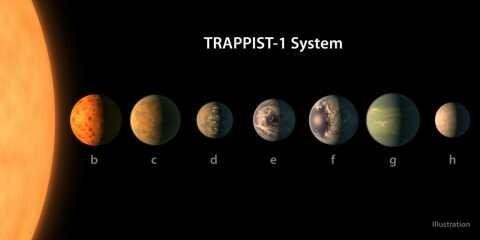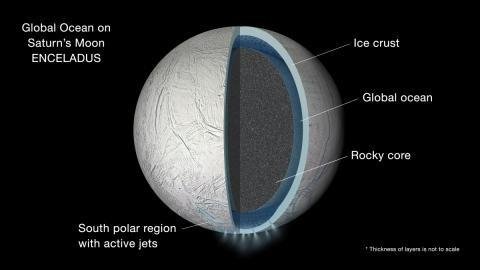Anonymous Says NASA Has Evidence of Alien Life. Does It?
Updated | Anonymous, the global hacking collective, believes that alien life exists—and that NASA is about to confirm it.
The shadowy group made the claim in a 12-and-a-half-minute video published on an unofficial YouTube channel on Tuesday.
But while Anonymous is right to point out that NASA is probably closer than ever in human history to discovering extraterrestrial life, it may be a leap to say concrete evidence for it exists.
NASA has made statements recently that suggest that the discovery of aliens is a matter of when, rather than if. “Taking into account all of the different activities and missions that are specifically searching for evidence of alien life, we are on the verge of making one of the most profound, unprecedented discoveries in history,” said Thomas Zurbuchen, the associate administrator of NASA’s Science Mission Directorate, before the House Committee on Science, Space in April.
But while Zurbuchen and others at NASA are enthusiastic about the prospect of finding alien life, they have not claimed to have actually done so.

It is true that space exploration has made massive advances in recent years. Since the Kepler Space Telescope was launched in 2009 it has discovered more than 4,000 possible planets, including 30 that are a similar size to Earth and could potentially sustain life.
NASA has even found evidence of another potential solar system—a collection of planets orbiting around a single star—located just 39 light years from Earth.
In February, NASA’s Spitzer Space Telescope team said it had found a system of seven planets orbiting Trappist-1. All of which were a similar size to Earth and three were located within the so-called "habitable zone" of the star—not so far away that water would freeze, nor too close that the planet would burn up.
Researchers have even been able to identify the specific location where life might be most likely to exist outside Earth. NASA’s Cassini spacecraft, in the final months of a 20-year mission earlier in 2017, pinpointed Enceladus, an icy moon of Saturn, as a key site for further exploration.
The surface of the moon is covered by an ocean encased in a thick shell of ice. But the Cassini also observed that plumes of gas, including hydrogen, were spewing out of a geyser and into space. Hydrogen is vital building block for life for micro-organisms, suggesting that some form of life could inhabit Enceladus.
Enceladus diagram Scientists on NASA's Cassini mission determined that the slight wobble of Enceladus as it orbits Saturn is much too large for the moon to be frozen from surface to core. The wobble, technically referred to as a libration, reveals that the crust of Enceladus is disconnected from its rocky interior. NASA/JPL-Caltech
But despite all these advances, extraterrestrial life remains a mystery. The director of NASA, Charles Bolden, told British schoolchildren in 2015 that he believed that “we will someday find other forms of life or a form of life, if not in our solar system then in some of the other solar systems.”
But Bolden declined to put a timescale on such a discovery and other experts—including popular astrophysicist Neil DeGrasse Tyson—have it at least 50 years away.
More optimistic scientists have said it could happen more quickly. These include NASA’s chief scientist, Ellen Stofan, who said in 2015 that she thought researchers would find “strong indications of life beyond Earth within a decade, and I think we’re going to have definitive evidence within 20 to 30 years.”

Stephen Hawking, who has recently said that humans should find alternative planets on which to live, has warned that if alien life forms reach out to Earth, human beings should be careful in how they respond.
And while space researchers are close to being able to identify extraterrestrial life, current telescopes do not allow them to spot the chemical fingerprints—traces of water and gases that indicate life, known as biosignatures—on planets outside the solar system.
That will soon change. In 2018, NASA will launch the James Webb Space Telescope, an ultra-sensitive device that means they will be able to observe traces of extraterrestrial life, should they exist.
If NASA had already found evidence of alien life, it’s unlikely that they would be sitting on their hands. The discovery would be a momentous political win for the United States, akin to winning the so-called space race against the then Soviet Union in July 1969 when Neil Armstrong stepped onto the Moon.
Hi! I am a robot. I just upvoted you! I found similar content that readers might be interested in:
http://www.newsweek.com/are-aliens-real-aliens-evidence-nasa-anonymous-628922
woow, nice post.
thanks
Vote Done
thanks bro
Not indicating that the content you copy/paste is not your original work could be seen as plagiarism.
Some tips to share content and add value:
Repeated plagiarized posts are considered spam. Spam is discouraged by the community, and may result in action from the cheetah bot.
Creative Commons: If you are posting content under a Creative Commons license, please attribute and link according to the specific license. If you are posting content under CC0 or Public Domain please consider noting that at the end of your post.
If you are actually the original author, please do reply to let us know!
Thank You!